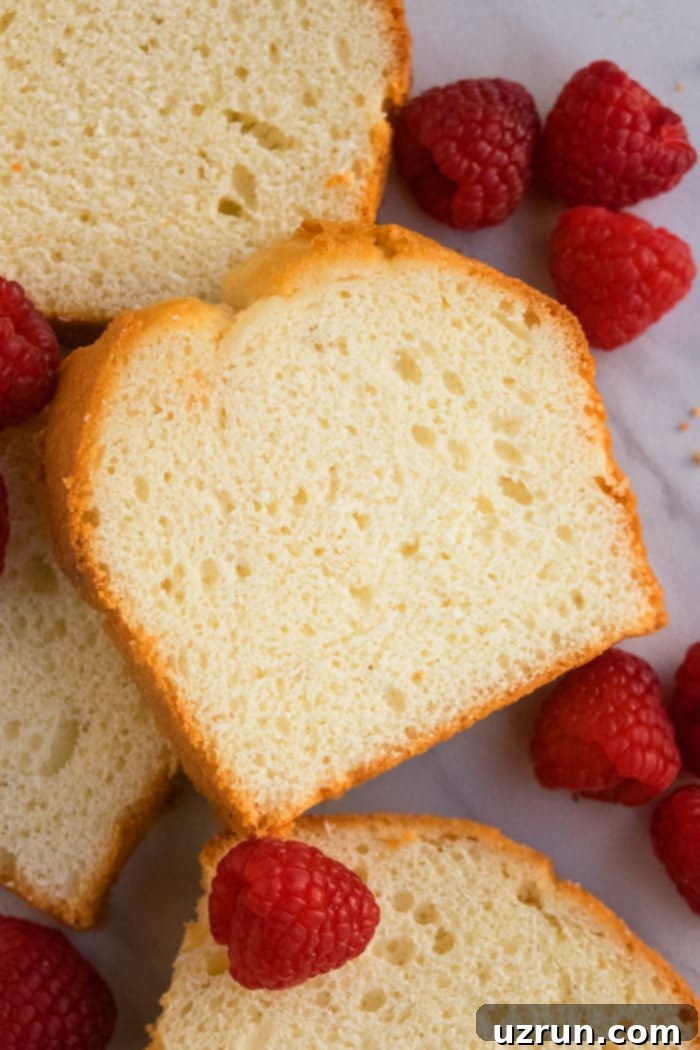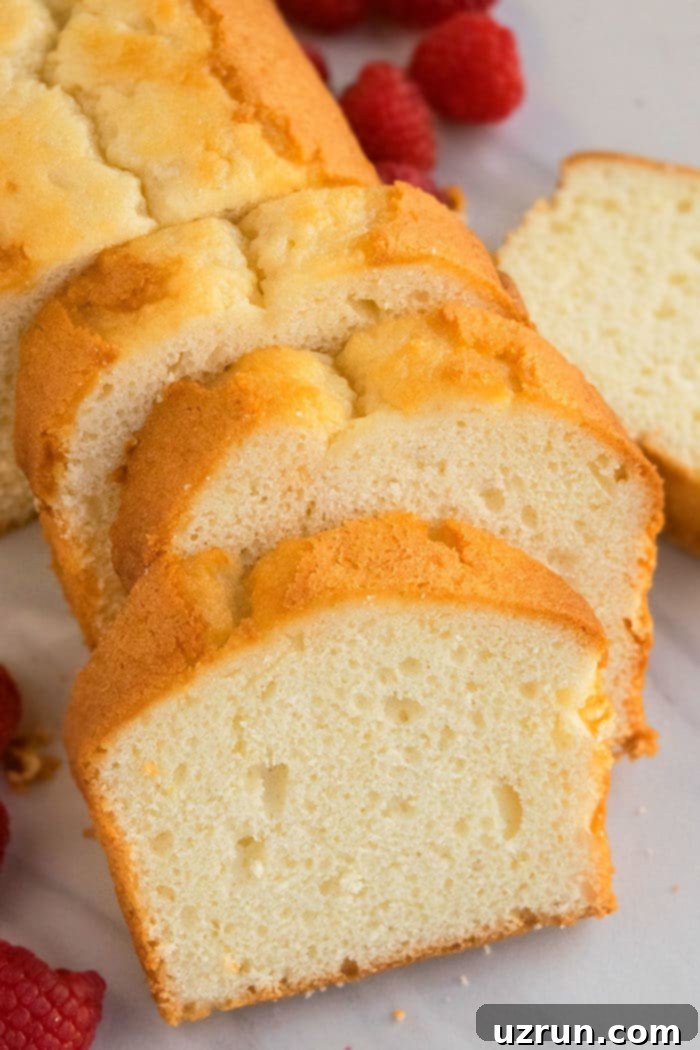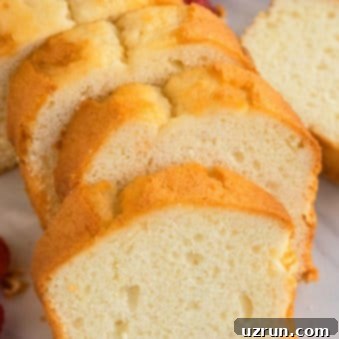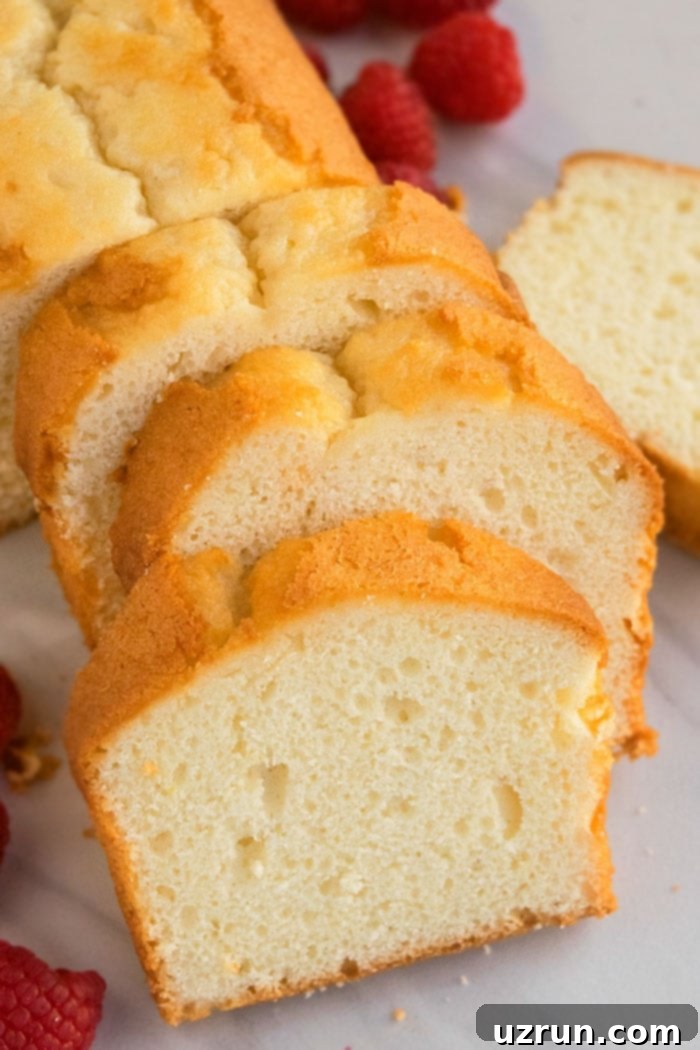Classic Buttermilk Pound Cake Recipe: Perfectly Moist & Easy Homemade Delight
Prepare to fall in love with this ultimate Classic Buttermilk Pound Cake recipe – a truly homemade delight that’s incredibly soft, moist, dense, and bursting with rich vanilla flavor. This recipe captures the essence of a traditional, old-fashioned pound cake, delivering a quick and easy baking experience with simple ingredients you likely already have on hand. Whether you’re a seasoned baker or just starting, this guide will help you create a show-stopping cake that will impress everyone.
If you’ve enjoyed our other popular recipes like the Cream Cheese Pound Cake, the Sour Cream Pound Cake, or even the elegant Marble Pound Cake, you’re in for a treat with this buttermilk version. It offers a slightly tangy note and an unbelievably tender crumb, making it a beloved classic that stands the test of time.

Why This Buttermilk Pound Cake Is a Must-Try
This buttermilk pound cake isn’t just another dessert; it’s an experience. The use of buttermilk is key, contributing to the cake’s signature fine crumb and adding a subtle tanginess that beautifully balances the sweetness. The result is a cake that is exceptionally moist, has a rich buttery flavor, and a satisfyingly firm texture that holds up well when sliced. It’s perfect for any occasion, from a casual family gathering to a more formal celebration.
- Unrivaled Moisture: Buttermilk’s acidity tenderizes the gluten in flour, leading to an incredibly moist and tender cake.
- Classic Flavor Profile: Pure vanilla extract shines through, giving it that timeless, comforting taste.
- Simple Ingredients: Made with everyday pantry staples, proving that extraordinary flavor doesn’t require exotic components.
- Versatile Base: A fantastic foundation for countless variations, allowing you to customize it with different glazes, frostings, and flavors.
- Easy to Make: Despite its sophisticated taste and texture, the preparation process is straightforward and manageable for bakers of all levels.
How to Make Buttermilk Pound Cake: A Simple Overview
Baking this delicious buttermilk pound cake is a straightforward process. Here’s a quick glance at the main steps involved:
- Cream Butter and Sugar: Start by beating softened unsalted butter with granulated sugar until the mixture is light and fluffy. This step incorporates air, which is crucial for the cake’s texture.
- Incorporate Wet Ingredients: Mix in large eggs one at a time, followed by a generous amount of vanilla extract, ensuring everything is well combined and smooth.
- Combine Dry Ingredients: Whisk together all-purpose flour and baking soda in a separate bowl to ensure even distribution.
- Alternate Wet and Dry: Gradually add the dry flour mixture to the wet ingredients, alternating with buttermilk, mixing just until combined. Avoid overmixing to prevent a tough cake.
- Bake to Perfection: Pour the batter into prepared pans and bake until golden brown and a toothpick inserted into the center comes out clean.
- Cool and Chill: Allow the cake to cool fully before wrapping and chilling overnight for the best texture and clean slices.
Understanding Your Key Ingredients
Each ingredient plays a vital role in achieving the perfect buttermilk pound cake. Understanding their function helps ensure success every time:
- Unsalted Butter (Room Temperature): Provides rich flavor and contributes significantly to the cake’s tender crumb. Using unsalted butter allows you to control the total salt content. Room temperature butter creams better, creating a smoother, lighter base.
- Granulated Sugar: Sweetens the cake and helps create a tender texture by interfering with gluten development. When creamed with butter, it also creates air pockets.
- Large Eggs: Act as a binder, add moisture, richness, and help with leavening. Using large eggs ensures the correct liquid-to-dry ingredient ratio.
- Vanilla Extract: The primary flavor in this classic cake. Use a high-quality pure vanilla extract for the best results.
- All-Purpose Flour: Provides the structure for the cake. Measuring correctly is crucial; too much flour can lead to a dry, dense cake.
- Baking Soda: A leavening agent that reacts with the acidity of the buttermilk to help the cake rise and achieve a lighter texture.
- Buttermilk: The star ingredient! Its acidity reacts with baking soda, and its thick consistency adds incredible moisture and tenderness without making the cake greasy. It also imparts a subtle tangy flavor.
How to Make Homemade Buttermilk (Substitute)
Don’t have buttermilk on hand? No worries at all! It’s incredibly easy to make a perfect homemade substitute with ingredients you likely already have. This simple trick ensures you can still make this delicious pound cake anytime inspiration strikes.
To create a fantastic buttermilk substitute:
- Measure out 1 cup of whole milk.
- Add 1 tablespoon of white vinegar or fresh lemon juice to the milk.
- Stir briefly and let the mixture sit undisturbed for 5 to 10 minutes.
- During this time, the milk will begin to curdle slightly and thicken, mimicking the consistency of real buttermilk.
- Give it another quick stir, and your homemade buttermilk substitute is ready to use in this recipe!
This substitute works perfectly, providing the necessary acidity and moisture for a tender pound cake.
Buttermilk Pound Cake Variations: Unleash Your Creativity
The beauty of this classic buttermilk pound cake is its versatility. You can easily adapt the flavors without drastically changing the core recipe, making it a fantastic base for all sorts of delicious experiments. Here are some ideas to inspire you:
- Fruity Frostings and Glazes: While delicious on its own, this cake pairs wonderfully with a variety of fruity toppings. Consider vibrant options like Maraschino Cherry Frosting, a bright Easy Orange Frosting, a tart Blackberry Buttercream Frosting, or a tropical Mango Frosting. These add a refreshing contrast to the rich cake.
- Simple Vanilla or Citrus Glaze: For an elegant finish, a simple glaze is always a good choice. It’s made by whisking together 2 cups of powdered sugar, 2 tablespoons of whole milk, 1 tablespoon of melted unsalted butter, and 1 teaspoon of vanilla extract until smooth and creamy. For a citrus twist, replace the vanilla extract with lemon, lime, or orange zest and a little of their juice for a brighter flavor.
- Different Extracts and Zests: Beyond vanilla, explore other aromatic extracts and fresh zests. A delightful lemon buttermilk pound cake can be made by adding the zest of two lemons and 1-2 teaspoons of lemon extract to the batter. Similarly, orange or lime zest and extract can create equally delicious variations.
- Chocolate Buttermilk Pound Cake: For chocolate lovers, this is a must-try! After baking, top the cooled cake with a decadent Chocolate Buttercream Frosting or a lighter Coconut Cream Chocolate Frosting. You can also fold a cup of mini chocolate chips into the batter before baking for bursts of chocolate in every bite.
- Spiced Pound Cake: Add warm spices like cinnamon, nutmeg, or cardamom (1-2 teaspoons total) to the flour mixture for a comforting, autumnal flavor profile.
- Nutty Pound Cake: Fold in 1/2 to 1 cup of chopped pecans, walnuts, or almonds into the batter for added texture and a nutty flavor.

Expert Tips & Techniques for the Best Buttermilk Pound Cake
Achieving a perfectly moist and flavorful buttermilk pound cake is easy when you follow these expert tips and techniques:
- Use Full-Fat, Room Temperature Ingredients: For the richest flavor and most tender crumb, always opt for full-fat ingredients like real butter and whole milk (if making a substitute). Ensure butter and eggs are at room temperature, as this allows them to emulsify properly with the sugar, creating a smooth batter that holds more air, leading to a lighter cake.
- Opt for Unsalted Butter: Using unsalted butter gives you complete control over the salt content in your cake, preventing it from becoming too salty. If you only have salted butter, reduce any added salt in the recipe by about ¼ teaspoon per stick of butter.
- Choose the Right Pan: This recipe works well in various pans. While two standard 8×4 inch loaf pans are suggested for even baking and easy slicing, a 10-inch Bundt pan is also an excellent choice for a more decorative presentation. Ensure your chosen pan is thoroughly greased and floured to prevent sticking.
- Be Patient with Baking Time: Pound cakes are dense and require a longer baking time, typically 60 to 90 minutes. Do not reduce the bake time, even if the top looks done, as the center might still be raw. Baking at a slightly lower temperature of 325°F (160°C) helps the cake bake through evenly without over-browning or burning the crust. Always test for doneness with a toothpick.
- Avoid Overmixing the Batter: Overmixing develops the gluten in the flour too much, which can result in a tough, chewy cake. Mix the dry ingredients into the wet ingredients only until just combined and no streaks of flour remain. A few small lumps are perfectly fine!
- Chill Overnight for Perfect Slices: While it’s tempting to dive in immediately, chilling the cake overnight after it has fully cooled makes a significant difference. It allows the cake to firm up further, making it much easier to cut neat, smooth slices without crumbling. This step is highly recommended for picture-perfect presentation.
- Storage and Freezing: Leftover pound cake can be stored in an airtight container at room temperature for up to 3 days or in the refrigerator for up to a week. For longer storage, you can freeze pound cake. Once completely cooled, wrap it tightly in plastic wrap, then place it in a sealed freezer bag. It will keep in the freezer for up to 1 month. Thaw overnight in the refrigerator before serving.
- Creative Decoration Ideas: This classic cake is beautiful in its simplicity, often served with just a dusting of powdered sugar. However, feel free to get creative! Drizzle with a simple vanilla or lemon glaze (as mentioned in variations), or go indulgent with Homemade Caramel Sauce or even Nutella Syrup. For a fresh touch, serve with a dollop of Homemade Whipped Cream and seasonal fresh berries. You can also add sprinkles, candies, chocolate chips, or even edible fresh flowers for a festive look.

Frequently Asked Questions About Buttermilk Pound Cake
Here are some common questions about baking and enjoying this classic dessert:
What makes a pound cake different from other cakes?
Traditionally, pound cakes were made with a pound each of butter, sugar, eggs, and flour, hence the name. This typically results in a denser, richer, and firmer cake than lighter sponge cakes or airy layer cakes. The absence of chemical leaveners in classic recipes (though modern versions often include a touch of baking soda or powder, like this one, for a slightly improved texture) and the high fat content define its unique texture.
Can I use self-rising flour?
It’s generally not recommended to substitute self-rising flour for all-purpose flour in recipes that call for a specific amount of leavening (like baking soda or powder). Self-rising flour already contains baking powder and salt, and using it could throw off the delicate balance of this recipe, leading to an unpredictable outcome.
My pound cake is dry, what went wrong?
A dry pound cake can be caused by several factors: over-measuring flour, not enough fat (butter or buttermilk), or overbaking. Ensure you’re measuring flour correctly (spoon and level method) and always test for doneness with a toothpick – it should come out with moist crumbs, not wet batter, but not completely dry either.
How can I prevent my pound cake from sinking in the middle?
Sinking can occur from overmixing the batter, opening the oven door too frequently during baking, or taking the cake out of the oven too soon. Ensure your oven temperature is accurate and resist the urge to peek during the first 45-50 minutes of baking.
What’s the best way to serve buttermilk pound cake?
This cake is incredibly versatile. It’s fantastic on its own with a cup of tea or coffee. For a more elaborate dessert, serve it with fresh berries, a scoop of vanilla ice cream, whipped cream, or a drizzle of fruit sauce. Its firm texture also makes it great for toasting or grilling slightly and serving with a fruit compote.
Other Classic Cake Recipes to Try
If you loved this buttermilk pound cake, you might enjoy exploring more classic and delicious cake recipes from our collection:
- Best Vanilla Cake Recipe (From Scratch)
- Chocolate Bundt Cake (From Scratch)
- Angel Food Cake
- Easy Black Forest Cake (With Cake Mix)
- Depression Cake (Wacky Cake)
- Homemade Pineapple Upside Down Cake
- Moist Red Velvet Cake
- Louisiana Crunch Cake
Recipe: Classic Buttermilk Pound Cake

Buttermilk Pound Cake
Abeer Rizvi
Pin Recipe
Want to Save This Recipe?
Enter your email & I’ll send it to your inbox. Plus, get great new recipes from me every week!
By submitting this form, you consent to receive emails from CakeWhiz
Ingredients
- 1 cup Unsalted Butter , Room temperature
- 2 ½ cups Granulated sugar
- 4 Large Eggs
- 2 teaspoon Vanilla extract
- 3 cups All-purpose flour
- ¼ teaspoon Baking soda
- 1 cup Buttermilk
Instructions
-
In a large mixing bowl, using an electric mixer, cream together the softened unsalted butter and granulated sugar until the mixture is light, fluffy, and pale in color. This usually takes about 3-5 minutes.
-
Add the large eggs one at a time, beating well after each addition until fully incorporated. Scrape down the sides of the bowl as needed. Stir in the vanilla extract and mix until the batter is smooth.
-
In a separate mixing bowl, whisk together the all-purpose flour and baking soda until they are well combined. This ensures the leavening agent is evenly distributed throughout the dry ingredients.
-
Gradually add the dry flour mixture to the wet butter mixture, alternating with the buttermilk. Begin and end with the dry ingredients. Mix on low speed just until the ingredients are combined and no dry streaks of flour remain. Be careful not to overmix, as this can lead to a tough cake.
-
Pour the prepared batter evenly into two greased and floured loaf pans (standard 8×4 inches). Use a spatula to gently spread the batter out evenly in the pans. Alternatively, you can use one 10-inch Bundt pan.
-
Bake in a preheated oven at 325°F (160°C) for 60-70 minutes, or until a wooden skewer or toothpick inserted into the center of the cake comes out clean or with moist crumbs attached. For even baking and browning, remember to rotate your pans halfway through the baking time.
-
Once baked, remove the cakes from the oven and let them cool in their pans for about 10-15 minutes. Then, carefully invert them onto a wire cooling rack and allow them to cool completely.
-
For the best texture and perfect, crumb-free slices, wrap the cooled cakes tightly in plastic wrap and chill them in the refrigerator overnight. Slice and enjoy the next day!
Notes
- Refer to all the detailed tips and techniques provided above for the best baking results.
- Leftover pound cake can be stored in a sealed container at room temperature for up to 3 days, or in the fridge for up to 1 week.
- For longer storage, freeze the fully cooled cake wrapped tightly in plastic wrap and then in a freezer-safe bag for up to 1 month. Thaw overnight in the refrigerator.
Nutrition
Calories: 334kcal
Carbohydrates: 50g
Protein: 4g
Fat: 13g
Saturated Fat: 7g
Cholesterol: 73mg
Sodium: 153mg
Potassium: 63mg
Sugar: 32g
Vitamin A: 440IU
Calcium: 30mg
Iron: 1.3mg
An automated tool is used to calculate the nutritional information. As such, I cannot guarantee the accuracy of the nutritional information provided for any recipe on this site.
Tried this recipe?
Leave a comment below or rate and tag @cakewhiz on social
We hope you enjoy baking and savoring this magnificent buttermilk pound cake as much as we do. It’s a timeless recipe that brings comfort and joy with every slice. Happy baking, my lovelies!
